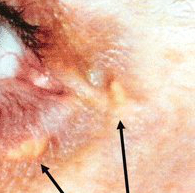Summary
Your Organisational Guidance
ebpracticenet urges you to prioritise the following organisational guidance:
Évaluation du risque cardiovasculaire en première lignePublished by: Domus MedicaLast published: 2010Cardiovasculaire risicobepaling in de eerste lijnPublished by: Domus MedicaLast published: 2020Definition
History and exam
Key diagnostic factors
- presence of risk factors
- family history of early onset of coronary heart disease or dyslipidaemia in first-degree relatives
- history of cardiovascular disease
- consumption of saturated fats and trans-fatty acids
- excess body weight (especially abdominal obesity)
- xanthelasmas
- tendinous xanthomas
Other diagnostic factors
- arcus cornealis with onset before the age of 45 years
- tuberous xanthomas
Risk factors
- insulin resistance and type 2 diabetes mellitus
- excess body weight (body mass index >25 kg/m²)
- cigarette smoking
- hypothyroidism
- cholestatic liver disease
- nephrotic syndrome
- use of certain medications
Diagnostic investigations
1st investigations to order
- lipid profile
- serum thyroid-stimulating hormone (TSH)
- lipoprotein(a)
Treatment algorithm
Contributors
Authors
Thorsten Leucker, MD, PhD
Assistant Professor of Medicine
Division of Cardiology, Department of Medicine
Johns Hopkins University School of Medicine
Baltimore
MD
Disclosures
TL has received grant funding for his university from Amgen and Merck.
Richard A. Ferraro, MD
Cardiovascular Disease Fellow
Division of Cardiology, Department of Medicine
Johns Hopkins University School of Medicine
Baltimore
MD
Disclosures
RAF declares that he has no competing interests.
Acknowledgements
Dr Thorsten Leucker and Dr Richard A. Ferraro would like to gratefully acknowledge Dr Seth S. Martin, Dr Rhanderson Cardoso, Dr Raul D. Santos, Dr Martin Engelhardt, and Dr Michael Miller, the previous contributors to this topic.
Disclosures
SSM has received honoraria from the American College of Cardiology for educational activities. SSM is listed as a co-inventor on a pending patent filed by Johns Hopkins University for a novel method of LDL-cholesterol estimation. SSM received a charitable gift for the VLDL big data project from the David and June Trone Family Foundation, and has also received research support from the PJ Schafer Cardiovascular Research Fund, American Heart Association, Aetna Foundation, iHealth, Stanford MedX/Nokia, Google, and Apple. SSM has acted as a consultant for Abbott Nutrition, Pressed Juicery, Quest Diagnostics, Sanofi/Regeneron, Amgen, Novo Nordisk, Esperian, Akcea, and the Pew Institute. RC declares that he has no competing interests. RDS has received honoraria for consulting, speaker activities and research from Astra Zeneca, Amgen, Akcea, Biolab, Esperion, Kowa, Pfizer, Merck, Novo-Nordisk, and Sanofi/Regeneron. ME declares that he has no competing interests. MM has received research grant support and honoraria for lectures from AstraZeneca, Merck-Schering Plough, and Pfizer. MM has received consulting fees from Pfizer, Merck-Schering Plough, and Roche.
Peer reviewers
Mahi Lakshmi Ashwath, MD
Assistant Professor of Medicine
Noninvasive Cardiology
MetroHealth Campus
Case Western Reserve University
Cleveland
OH
Disclosures
MLA declares that he has no competing interests.
Deepak Bhatnagar, TD MBBS PhD FRCP FRCPI FRCPath
Consultant/Senior Lecturer in Diabetes & Metabolism
The Royal Oldham Hospital & University of Manchester Cardiovascular Research Group Diabetes Centre
Royal Oldham Hospital
Oldham
UK
Disclosures
DB declares that he has no competing interests.
Use of this content is subject to our disclaimer
